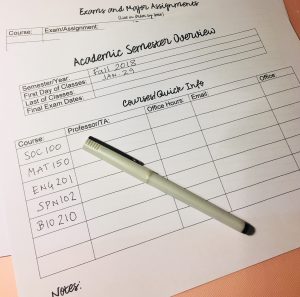Every semester, I want to be more organized. Even after 20 years of teaching, every semester I need make tweaks to my system, learning from what worked and didn’t work. Inevitably, I can always do better. A lot of students visit me during office hours and tell me how “together” they think I am. (Full disclosure: I don’t think I’m very “together” but I try!) But I freely admit to them that I’m easily distracted and I’ve got a lot going on. I’ve learned (the hard way) a few things about how to manage all the juggling I have to do. Most students (like most professors) are struggling with their own juggling acts so I have a few pretty simple (and maybe fairly obvious) strategies and some resources to help you with managing the chaos of the semester given the many things competing for your time and attention.
Let’s start with an organizing strategy for the beginning of the semester that will help you stay on top of things when things start to get busy later on.
The first and simplest strategy is to have one dedicated folder/binder/notebook per course. Depending on the course and how you like to organize and how much stuff you’re willing to lug around with you, if you use a laptop for notes, etc., what you use will vary. But, have one dedicated “vessel” for each course (and don’t be the student who accidentally gives me their English research paper and the English professor their sociology paper because they keep all their stuff in one folder.) And while you’re at it, choose a different color binder/folder/notebook so that when you’re grabbing what you need for the day, you don’t have to check inside to see if it’s your math or Spanish notes. (If you’re ADD/ADHD like me, this will be especially helpful.) Staples or dollar stores have lots of affordable options at back to school time so you don’t need to spend a lot of money. (And if you’re one of my students and you come to my office hours for organizational or time management help, I’ll probably gift you one from my horde of school and office supplies.)
Should I use electronic or paper methods for organization? I say use both. I use Outlook which syncs with ICal for calendar stuff like appointments, meetings, classes, etc. I also use a paper planning system and always have some kind of notebook or journal with me at all times to write to do’s, tasks, and well, to makes notes. You have to figure out how your brain works but for a lot of people, the act of physically writing things down and/or having a paper/tactile visual, helps them remember, brainstorm and more productive. And speaking of paper, let’s now turn our attention to the dreaded SYLLABUS.
Students are anxious to have them (imagine how annoyed you’d be if you showed up the first day of class and the professor was like, oh shoot, I don’t have my syllabus ready) and professors rely on them to communicate expectations to students. We all have a love/hate relationship with the syllabus. But my number one piece of advice is to read the darn syllabus–but you don’t have to memorize it or re-read it every week.
Try this instead: during that first week of classes, take a little time to go through all your syllabus, highlight exam and due dates, and put all important dates and due dates into whatever reminder system/planner/app you use. Even better, make an overview of all the important info, contacts, exams and due dates in one document that you can refer to whenever you have to email a professor or go to office hours. Having a “cheat sheet” means you don’t have to dig through all your syllabi every time you need important information. To make this easier, I created this handy sheet:

Semester Overview for Students-Printable
Print out this three page semester overview and sit down with the syllabus for every course you’re taking this semester. It’s pretty self-explanatory. You fill out the start and end dates for the semester, make note of all the names of your professors and/or TAs, their contact info, office hours, and locations. This way, if you’ve got to email your professors because you’re sick and won’t be coming to class on Wednesday, you won’t have to dig through a bunch of syllabi. Then, list by date, all the exam dates and due dates for big assignments for every class. Put it in one list by date so you have a clear visual of what’s coming up for all your classes. This will help you plan out your study and reading/writing schedule (and if you’ve never done that before, you should start this semester, using this info!) Finally, fill out your classes on the grid/timetable–this will help you visualize what hours you have left for work, studying, family responsibilities, and possibly having a life. At the bottom, write down the hours and locations of academic resources, like tutoring and the writing center. You may not think you need it but have the info handy anyway. Now, put this somewhere you will see and use it–hang it up on a bulletin board above your desk, put it in the folder or notebook you have for general notes (watch for a future post on the “everything notebook) or heck, take a picture of it with your phone so you can pull it up anytime, anywhere.
For more tips and resources for having a successful semester, check out my Pinterest board:
https://www.pinterest.com/ProfSalam/advice-for-college-students/
If this helped you out or if you have any suggestions or would like to share your strategies for getting yourself organized for the semester, leave me a comment.
Stay tuned for more resources to help you stay focused and work smarter.


Recent Comments